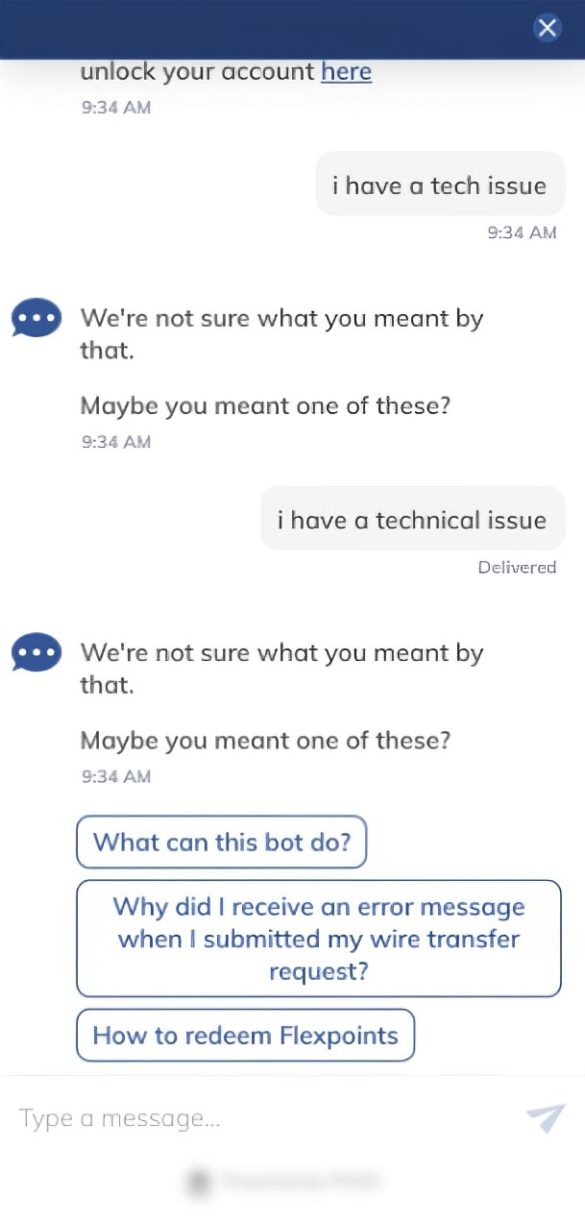When conversational AI banking is designed and implemented successfully, it can be a game-changer for your digital customer experience. A great banking chatbot can save people time, let them solve problems on their own, and help free up your contact center staff for more involved customer inquiries.
When a chatbot isn’t quite up to snuff, however, it can send you backwards instead of forwards in your progress towards an improved online infrastructure.
Chatbots that fail to deliver on the promise of an improved customer satisfaction can not only drive people away from the feature, but possibly from your financial institution entirely. Four common failures can negatively impact a chatbot’s ability to serve customers:
- Poor Coverage/Poor Accuracy
- Lack of Precision
- Poor Bot Memory For Context
- Being Model Centric, Not Data Centric
These issues can all be avoided, so long as your chatbot provider is aware of possible shortcomings and has methods of preventing these common pitfalls.
1. Poor Coverage/Poor Accuracy
While subtly different, and sometimes hard to tell apart, these two problems can lead to the same result: the chatbot providing poor, incorrect or incomplete answers.
Poor coverage is when a chatbot is not given the proper information needed to answer a user’s question. If a chatbot is not informed on the interest rates on a certain credit card, or is not given the operating hours of a certain branch, it simply cannot answer questions about either of these items.
Poor accuracy happens when the chatbot is unable to understand the question itself. It might know the interest rate of that particular card, but if it cannot parse that the user is asking for that information then the bot will still fail to answer it regardless. It may try to answer a different question instead, as seen below:
No matter which of these issues affects your chatbot, the result will be a chatbot unable to perform its one job: answering user questions. This leaves a bad impression on your user and will cause them to write this new feature off as pointless.
Breaking Point:
Chatbots need good coverage and accuracy if your financial institution wants the technology to perform well. Otherwise, it will fail its primary job: taking care of people’s questions and concerns.
2. Lack of Precision
Similar to poor accuracy, a chatbot with a lack of precision is unable to provide concise, granular answers to a user’s questions. It will provide the same answer to many different queries, often trying to contain as much information as possible to cover every variant question under a larger umbrella. This scattershot method of answering questions will confuse your user more than help them, and make them perform much more work than necessary to locate answers to even the simplest of questions. See how poorly a lack of precision in your answers can look in the example below:
If a chatbot has not been trained to recognize the subtle differences in various user inquiries or ask further clarifying questions, it will need to give every possible answer to a certain area of questioning at once to compensate. This is rather unsatisfactory in a digital messaging environment, where short responses are necessary for natural-sounding conversation.
3. Poor Bot Memory for Context
The ability to remember what was said earlier in a conversation, and form our responses around this, is a vital aspect of human conversation. This is something that comes naturally to us, but a chatbot must be particularly trained to mimic this behavior.
If a chatbot cannot remember what the user has previously told it, it will lead to a frustrating user experience. Nobody likes to repeat themselves, so being forced to enter the same information again and again will have your user looking for a live agent before long. This issue is even more common in instances where the chatbot hands the user off to a different space, such as a new web page or a live-agent chat.
4. Being Model Centric, Not Data Centric
All AI-driven chatbots rely on good, domain-specific data in order to function in an optimal fashion.
You may find a chatbot that uses one of the latest, greatest, state-of-the-art models to function, but how good will it function if it doesn’t have the data to back it up? Some mistakenly prioritize the quantity of the data above the quality, or aim for model accuracy above all else, and forget to invest time and energy into their data models as well. Getting great data that’s both specific to the banking industry and your specific organization is crucial to the success of your chatbot implementation.
Double Check:
Did your financial institution find a chatbot with all the bells and whistles? If so, make sure your technology team is checking that the behind-the-scenes data models can keep up with the chatbot.
Conclusion
A good banking chatbot is an invaluable asset to your financial institution, but it’s vital that you avoid these common missteps during the execution. The best way to stay clear of these all-too-common mistakes is to seek out a full-service AI chatbot vendor that specializes in the banking domain, who has all the financial-specific data and training needed to serve your customers intelligently and efficiently.
Be sure that you seek out the expertise of industry professionals that are aware of how a banking chatbot can fail, and your new conversational AI asset will be improving customer satisfaction immediately.
Additional Resources:
Free Guide eBook: 5 Reasons Your Chatbot Failed Your User
On-demand Fireside Chat: Why Chatbots Fail










